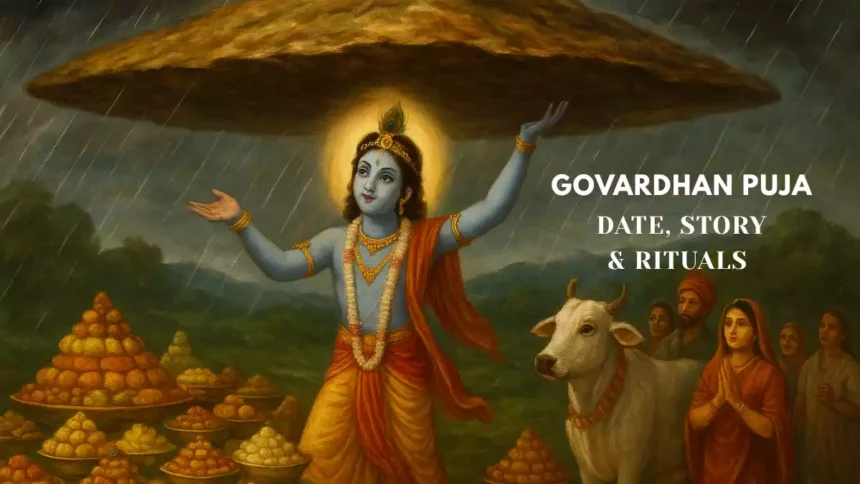As the lights of Diwali fade into the night, a quieter joy emerges the very next day. Govardhan Puja arrives like a gentle reminder of protection and thanks. This festival honors Lord Krishna’s bold stand against pride, celebrating how nature shields us all.
It ties right into Diwali’s glow but shifts the focus to earth and community. Rooted in ancient tales from Vrindavan, the day draws devotees to revere Govardhan Hill. Here, faith meets the land that feeds and guards life itself.
Determining the Date and Timing for Govardhan Puja 2025
When is Govardhan Puja Observed?
Govardhan Puja 2025 falls on October 21. That’s the day after Diwali, which lights up October 20 that year. This date comes from the Hindu lunisolar calendar, landing on the Pratipada Tithi of Shukla Paksha in Kartik month.
Tithis mark lunar phases, so they slide around the Gregorian calendar each year. No fixed spot like Christmas—it’s all about the moon’s cycle. Families check local panchangs for exact shifts, but October 21 holds steady for 2025 across most places.
This timing keeps the festival close to Diwali’s energy. It builds a bridge from wealth worship to nature’s gifts. You can mark your calendar now and plan ahead.

Auspicious Timings (Muhurat)
The main puja happens in the morning for Govardhan Puja 2025. Look for the Pratah Kal Muhurat, often from 6:30 AM to 8:00 AM, depending on your city. Sunrise sets the tone, with Abhijit Muhurat around noon as a backup if mornings clash.
Evenings bring Gauri Puja timings, say from 6:00 PM to 8:00 PM in some traditions. These windows come from Vedic astrology to boost the rituals’ power. Always peek at apps or temple calendars for precise local hours—they vary by location like Delhi or Mumbai.
Picking the right muhurat makes the day feel blessed. It aligns your actions with cosmic flow. Simple tools online can help you nail it without stress.
The Sacred Tale: The Story of Lord Krishna and Govardhan Hill
Indra’s Arrogance and the Challenge
Long ago in Vrindavan, folks prayed to Indra for good rains. As the rain god, he demanded big worship each year. His pride grew fat on their offerings and feasts.
The villagers toiled to please him, fearing dry fields without his favor. Indra soaked up the glory, blind to the land’s quiet role in their lives. But young Krishna saw through the show.
He stepped up with a simple question: Why chase a far-off god when the hill right here saves your cows? Krishna’s words stirred doubt in the crowd. They paused, weighing old habits against new truth.
Krishna’s Intervention and Lifting the Mountain
Krishna convinced everyone to skip Indra’s rite. Instead, they circled Govardhan Hill with flowers and songs. They offered food to the earth that grew their crops.
Fury boiled in Indra. He unleashed storms that flooded the land for seven days. Rivers swelled, homes shook—chaos everywhere.
Krishna grinned and lifted the hill on his pinky finger. It became a giant umbrella over Vrindavan. Cows huddled safe, kids played beneath, and faith bloomed strong.
The act showed Krishna’s might and wit. No god outranks nature’s true guard. Villagers watched in awe as the boy held back the sky.
Indra’s Surrender and the Enduring Legacy
The rains stopped at last. Indra bowed low to Krishna, owning his mistake. He named the hill Govardhan, meaning “protector of cows.”
From then on, the god learned humility’s sting. Krishna’s win echoed through time, a tale of right over might. It shaped festivals we cherish today.
This story lives in every Govardhan Puja chant. It reminds us pride crumbles fast. Gratitude to the hill keeps the legacy alive, year after year.
Core Rituals and Observances of Govardhan Puja
Annakut: The Mountain of Food Offerings
Annakut forms the heart of Govardhan Puja rituals. Devotees cook heaps of veggie dishes, piling them high like a mini mountain. This honors the hill Krishna raised, a feast for gods and all.
Think dal, rice, sabzis, and over 50 types in big temples. Sweets like laddoos and halwa top it off—no onions or garlic to keep it pure. Start early: chop veggies fresh, simmer pots with love.
Families share the spread after puja. It feeds the needy too, turning thanks into action. Such abundance mirrors the story’s plenty under the hill.
In 2025, try a home Annakut with 10 dishes. List basics:
- Steamed rice and lentils
- Fried breads like pooris
- Veggie curries with seasonal greens
- Jaggery sweets for that sweet finish
This ritual binds home and heaven. It tastes like gratitude on your plate.
The Significance of the ‘Govardhan Parikrama’
Govardhan Parikrama means walking around the sacred hill or its model. You circle a mud mound at home, chanting Krishna’s names. Each step cleanses the soul, they say.
In Mathura, the real 21-km path draws thousands. It takes hours, but the peace sticks. Kids join too, making it a family bond.
Spiritually, it builds devotion and stamina. Like life’s turns, the walk teaches patience. End with a dip in holy waters if you can.
For 2025, even a small home version counts. Light diyas along the path. Feel the story come alive with every stride.
Worship of Cattle and Nature
Cows and bulls get star treatment on this day. Bathe them with turmeric water, deck with garlands. Feed jaggery and greens as thanks for their milk and toil.
Krishna herded cows, so this honors his world. No meat touches the home—pure veg vibes rule. Plants get a nod too, with leaves in offerings.
Watch a cow’s calm eyes; it mirrors the hill’s steady watch. This rite links us to farms and fields. Simple acts like this keep traditions fresh.
Extend it: Plant a tree post-puja. It nods to nature’s role in the tale.
Regional Variations and Celebrations
The North Indian Tradition
Up north, especially in Braj lands like Vrindavan and Mathura, Govardhan Puja shines bright. Folks build mud hills at home, paint them with colors. They circle it 108 times for luck.
Temples host massive Annakuts that spill into streets. Music fills the air—flutes and drums echo Krishna’s leelas. Communities share food, strengthening ties.
This area owns the story’s roots, so vibes feel electric. In 2025, expect crowds at Govind Dev Temple. It’s raw faith mixed with local flavor.
Gujarat adds its twist with garba dances late into night. Everywhere, the focus stays on Krishna’s playful power.
The South Indian Connection: Bali Pratipada
Down south, some call it Bali Pratipada, tying to King Bali’s tale. Vamana, Vishnu’s dwarf form, humbled the king with three steps. Themes of surrender match Govardhan’s humility.
In Tamil Nadu or Karnataka, pujas honor earth with similar foods. No big hill lift, but stories blend dharma’s call. Families draw rangolis of mountains.
Overlaps keep it united—gratitude rules both. South feasts feature idlis and payasam in Annakut style. It’s a fresh take on the same spirit.
Explore these links to see Hinduism’s wide reach. Each spot adds its color to the day.
Govardhan Puja: Lessons in Humility and Ecology
Gratitude Over Greed
The tale flips worship from Indra’s demands to Govardhan’s gifts. Why bow to storms when the hill gives shade and food? It pushes humility front and center.
Krishna teaches us to spot real blessings. Greed blinds like Indra’s rain; thanks opens eyes. In daily life, swap wants for what you have.
Ask yourself: What sustains me without asking back? This shift builds inner peace. Govardhan Puja nudges that choice every year.
Early Environmentalism
Krishna’s lift screams care for the land. Protect the hill, and it protects you—ancient green wisdom. No exploit, just balance.
Today’s eco talks echo this: Save forests to fight floods. The story predates science books by ages. It shows nature as ally, not foe.
Act on it: Cut waste on puja day. Use local veggies for Annakut. Small steps honor the old lesson.
This view makes the festival timely. It ties faith to planet care.
Conclusion: Carrying Forward the Spirit of Govardhan
Govardhan Puja 2025 blends date, rituals, and Krishna’s timeless story into one grateful day. From Annakut feasts to hill walks, it celebrates protection and nature’s bond. Regional twists add depth, while lessons on humility and ecology hit home.
Beyond October 21, carry this vibe forward. Thank the earth in small ways—plant, share, reflect. Let Krishna’s pinky lift remind you: Strength lies in service, not show.
Dive into these traditions this year. Your heart—and the world—will thank you.

